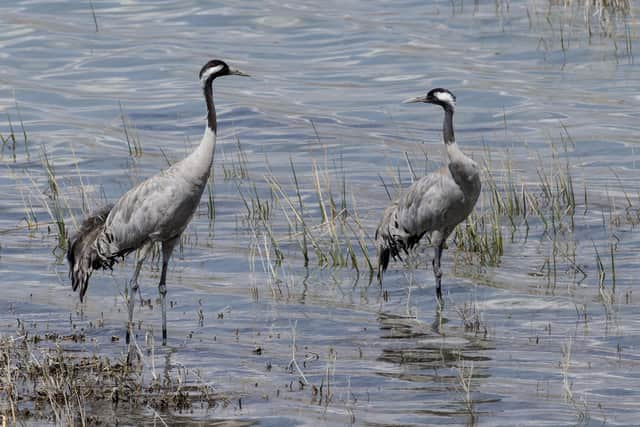These regal birds gave me goosebumps as I watched them return against all odds - Philip Lymbery
Everywhere was cold and quiet, the kind of brittle stillness where the snap of a twig rippled through the air. For ages, nothing happened. Then came an evocative sound that gave me goosebumps: a rattling bugle like the trumpeting of an elephant. I was far from Africa, but these creatures were no less exotic. Flying fast, with long, deep-fingered wings, protruding necks and trailing legs, a flight of cranes was coming into view, a species making a comeback in Britain against all odds.
Centuries ago, these regal birds were a common sight in Britain. Many place names such as Cranleigh, Cranfield and Cranmere reflect their once prolific presence along rivers, farms and lakes. During the 17th Century, they were wiped out as their wetland habitats were drained, largely to make way for agriculture.
Advertisement
Hide AdAdvertisement
Hide Ad

In recent years, they’ve been making a comeback, reaching as far north as North East Scotland, where several pairs have since nested. Recent data estimates the crane population across the UK to have now reached well over 200 birds – news that I find an inspiration.
And the great news is that, as with so many iconic species, protecting them helps so much else too. For example, cranes nest on Scottish peat bogs. Protecting and restoring these threatened habitats, not only benefits the cranes but also helps tackle climate change through storing vast amounts of carbon.
The return of the cranes is a cause to celebrate, and one bucking the trend of an otherwise downward spiral in our wild bird populations.
According to the latest data, the UK today is home to 73 million fewer breeding birds when compared to 1970. Birds familiar for adorning our homes and gardens have been disappearing in droves. In the last 50 years, almost 30 million House Sparrows, 20 million Starlings, four million Skylarks and two million Blackbirds have been lost. The silent skies are becoming deafening.
Perhaps the most striking losses have been across that major habitat covering three-quarters of the nation’s surface area: farmland. Since 1970, populations of key farmland bird species have fallen by more than half.
Species hardest hit include the Corn Bunting, Grey Partridge, Turtle Dove and Tree Sparrow, all of which have suffered losses of at least 90%.
Report after report shows that nature is in trouble with the chief offender for causing losses across Britain, Europe, and elsewhere being the move to intensive farming.
No wonder prominent TV wildlife host, Chris Packham, says enough’s enough; that nature doesn’t need another report – it needs restoring now. He led more than 40 wildlife charities and climate organisations in demanding government ministers take stronger action to restore nature.
Advertisement
Hide AdAdvertisement
Hide AdWhat the return of that tallest of birds, the common crane, shows is, where there’s a will, there’s a way. Give nature a chance, and the most extraordinary things happen.
And in so doing, we all benefit from the knock-on effects in tackling climate change, pollution, and boosting our own well-being.
